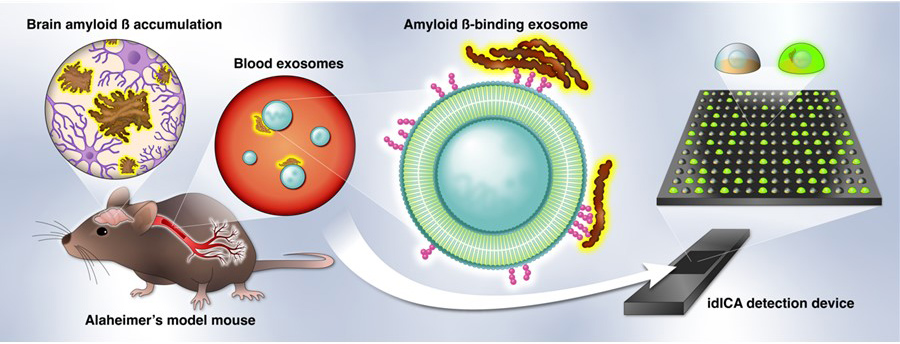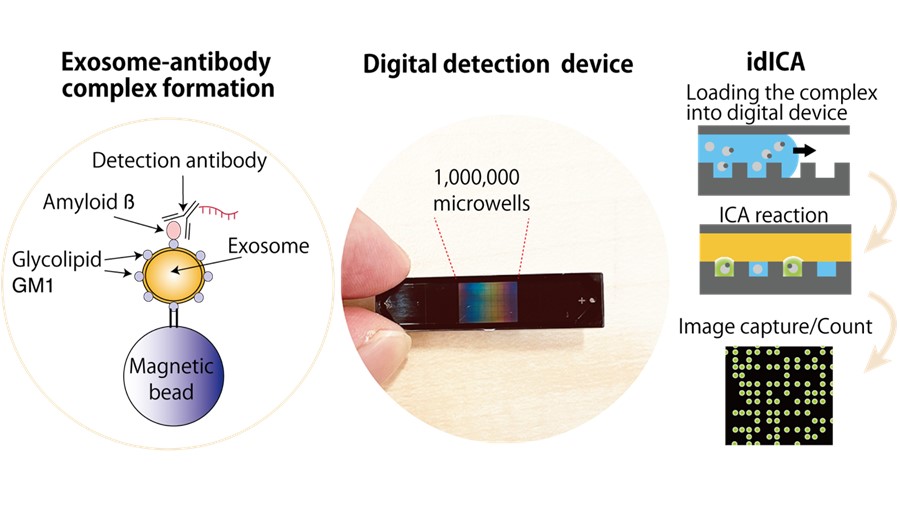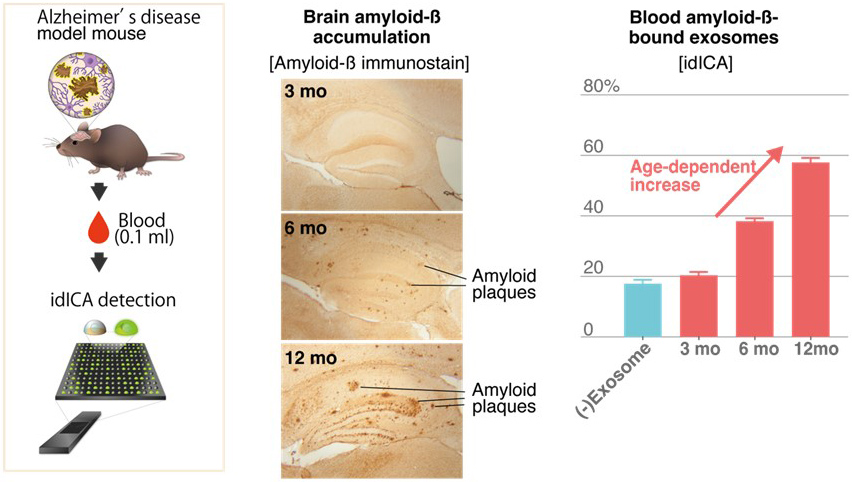A Hokkaido University research group, led by Specially Appointed Associate Professor Kohei Yuyama of the Faculty of Advanced Life Science, and Toppan (TYO: 7911), a global leader in communication, security, packaging, décor materials, and electronics solutions, have succeeded in developing a technology to identify and detect individual amyloid β1-binding exosomes,2 which are potential blood biomarkers for assessing the risk of Alzheimer's disease.3
Key points
・Digital detection technique for amyloid β-binding exosomes successfully developed.
・Age-related increase of amyloid β-binding exosomes confirmed in the blood of a mouse model of Alzheimer's disease.
・Findings hold promise for the development of next-generation early diagnosis techniques for Alzheimer's disease.

The Yuyama research group and Toppan have developed a highly sensitive biosensing technology that probabilistically traps target molecules and particles one by one in a million micrometer-sized microscopic wells4 integrated on a detection chip, which is then used to digitally detect and quantify targets based on the presence or absence of signals emitted from the molecules and particles. Toppan's proprietary Digital ICA™ technology is used for signal detection, enabling quantitative detection of amyloid β-binding exosomes using a small amount of blood (about 100 microliters) from a mouse model of Alzheimer's disease. Using this technology to measure amyloid β-binding exosomes in the blood of a mouse model of Alzheimer's disease over time, researchers found that the amount of amyloid β-binding exosomes increased due to accumulation of amyloid β in the brain as age increases.
Based on previous studies by the Yuyama research group, it is suggested that amyloid β-binding exosomes are involved in amyloid β accumulation—an early pathology of Alzheimer's disease. Detecting this specific exosome as a blood biomarker will contribute to the development of preventive medicine by enabling simple and rapid diagnosis of preclinical or early Alzheimer's disease.
The results of the present research project were published online in Springer Nature's scientific journal, Alzheimer's Research & Therapy, on October 3.
About the research paper
Title: Immuno-Digital Invasive Cleavage Assay for Analyzing Alzheimer’s Amyloid ß-Bound Extracellular Vesicles
Authors: Kohei Yuyama*, Hui Sun*, Yasuyuki Igarashi*, Kenji Monde*, Takumi Hirase**, Masato Nakayama**, Yoichi Makino** (*Faculty of Advanced Life Science, Hokkaido University, **Toppan Inc.)
Journal: Alzheimer's Research & Therapy (A journal specializing in dementia research)
DOI: 10.1186/s13195-022-01073-w
Publication date: October 3, 2022
URL: https://alzres.biomedcentral.com/articles/10.1186/s13195-022-01073-w
Background of the research
In Japan's super-aging society, overcoming Alzheimer's disease, which is primarily caused by aging, has become a pressing social issue. Alzheimer's disease is believed to be caused by the accumulation of a protein called amyloid β (Aβ) in the brain, which degenerates nerve cells. Therapeutic and prophylactic methods that prevent or eliminate the accumulation of Aβ are currently being developed around the world. Detection technologies to evaluate the state of Aβ accumulation in the brain are also being developed.
Since Aβ accumulation begins more than 20 years before the onset of Alzheimer's disease (when cognitive function is near normal), techniques to assess Aβ accumulation are important for early treatment and prevention of the disease before it develops. Currently, cerebrospinal fluid testing and positron emission tomography (PET) imaging are already in practical use as methods for detecting Aβ accumulation. However, cerebrospinal fluid testing is highly invasive and so is not repeatable, and PET testing requires expensive equipment and reagents, limiting the number of hospitals where the test can be performed. There are high hopes for any technology that can detect Aβ accumulation using blood biomarkers and other methods that can be tested easily and repeatedly.
To address these issues, the Yuyama research group and Toppan have successfully developed the "immuno-digital invasive cleavage assay (idICA) method," a highly sensitive detection technology for amyloid-β bound exosomes, using their accumulated knowledge of exosomes of specific brain substances and Digital ICA™, a highly sensitive fluorescence detection technology for distribution and detection of individual molecules.
Overview of the research
Using the "idICA method" developed by the joint research group, the amount of Aβ-binding exosomes in the blood of a mouse model of Alzheimer's disease was measured and found to fluctuate according to the level of Aβ accumulation in the brain.
Exosomes secreted into the blood from various tissues have attracted attention in recent years as biomarker candidates that can be continuously observed in a minimally invasive manner.
The Yuyama research group’s previous studies have shown that exosomes secreted by neurons have the ability to degrade and remove Aβ by binding and transporting Aβ to microglia, suggesting that they are involved in amyloid accumulation in the brain.
The highly sensitive biosensing technology that detects exosomes presented in the research paper is a method of detecting and quantifying targets by probabilistically trapping target molecules and particles one by one in a million micrometer-sized microscopic wells on a measurement chip and detecting the presence (1) or absence (0) of signals emitted by the molecules and particles. Using Digital ICA™, Toppan's proprietary high-sensitivity fluorescence detection technology, the research has succeeded in detecting exosomes containing glycolipid GM15 bound by Aβ leaked from brain tissue, which is present only slightly in blood (Figure 1).

Using this detection technology, researchers measured the amount of Aβ-binding exosomes in the blood of a mouse model of Alzheimer's disease over time and found that the blood exosome levels gradually increase with age (Figure 2). This suggests that it is possible to evaluate the level of Aβ accumulation in the brain by detecting Aβ-binding exosomes in blood. Through future clinical trials on human subjects, the parties will establish this evaluation technology to realize simple and rapid diagnosis of preclinical or early Alzheimer's disease and contribute to the development of preventive medicine.

Features of Digital ICA™, a highly sensitive fluorescence detection technology
This technique uses one million tiny wells on a substrate and a detection reagent to distribute biomolecules such as DNA into the wells one molecule at a time and detect them individually.
・Makes rapid diagnosis possible
The use of microwells allows for concentration of molecules targeted for detection, enabling measurement and quantification in a short time and rapid diagnosis.
・Enables miniaturization of detection equipment
Compared to PCR-based testing devices, which require the temperature to be raised and lowered, the use of isothermal enzyme reactions makes it possible to miniaturize detection devices.
・Applying the same technology to molecules and particles other than DNA
Detects not only DNA, but also proteins, viruses, and exosomes.
Roles of each organization
Hokkaido University
Leveraging its expertise in research on biolipid functions, Hokkaido University’s Faculty of Advanced Life Science has conducted technological development to enable the neurological functions of exosomes, which are lipid membrane particles, to be applied in dementia diagnosis technology. Efforts targeting practical implementation are also being advanced at the Cognitive Science Research Center in the Hokkaido University Collaborative Project Center, which was launched in fiscal 2022.
Toppan
Through the development and manufacture of diagnostic reagents, Toppan has cultivated technologies related to medicine and pharmaceuticals, including molecular diagnostic technologies. Utilizing this knowledge, Toppan has developed Digital ICA™, a highly sensitive fluorescence detection technology, as well as research kits and testing kits. Digital ICA™ technology was developed by Toppan for the research group led by Associate Professor Yuyama. The company is advancing the development of technologies for the detection and quantification of exosomes.
Toppan is committed to the development of preventive medicine and the improvement of quality of life through the provision of Digital ICA™, a highly sensitive fluorescence detection technology, and research and testing kits.
Hokkaido University and Toppan will collaborate to establish an early diagnosis method for Alzheimer's disease by combining their respective technologies, knowledge, and experience.
Expectations for the future
The technology developed enables highly sensitive detection of exosomes that retain specific surface molecules from a small amount of blood without the need to learn special techniques, as long as a detection chip and a general-purpose fluorescence microscope are available. The correlation between Aβ accumulation in the brain and Aβ-binding exosomes in blood is currently being examined using human samples from patients with Alzheimer's disease and mild cognitive impairment (MCI) at the Cognitive Science Research Center in the Hokkaido University Collaborative Project Center. The intention in the future is to develop next-generation detection methods for the early diagnosis of Alzheimer's disease.
Since this detection technology can also be used to detect exosome biomarkers other than Aβ, it holds promise as a fundamental technology for the development of next-generation liquid biopsies6 using exosome biomarkers, such as stratified diagnosis of multiple neurological diseases.
2. Exosome: A type of extracellular vesicle secreted by various types of cells. They engulf specific molecules and serve as carriers to pass them between cells.
3. Alzheimer's disease: The most common causative disease of dementia. An irreversible, progressive neurological disease that gradually impairs memory and the ability to think.
4. Microwells: A million micrometer-diameter recesses are created on the analysis chip surface. After storing the molecule to be detected, they become reaction vessels in which the detection reaction takes place.
5. Glycolipid GM1: A type of ganglioside that is found in the outer layer of cell and exosome membranes. It regulates various cell functions such as proliferation, adhesion, and signaling.
6. Liquid biopsy: Detecting components in blood and body fluids to obtain information necessary for diagnosis and treatment of specific diseases.
About Hokkaido University
Founded in 1876 as Sapporo Agricultural College, Hokkaido University is one of the oldest, largest, and most prestigious universities in Japan. The university attracts prospective students all around the globe with the diverse degree programs offered and the year-round scenic beauty. The campuses are located in the cities of Sapporo and Hakodate of Hokkaido, and 21 facilities are spread throughout Hokkaido and mainland Japan, contributing towards the resolution of global issues.
Visit https://www.global.hokudai.ac.jp/
About Toppan
Established in Tokyo in 1900, Toppan is a leading and diversified global provider committed to delivering sustainable, integrated solutions in fields including printing, communications, security, packaging, décor materials, electronics, and digital transformation. Toppan’s global team of more than 50,000 employees offers optimal solutions enabled by industry-leading expertise and technologies to address the diverse challenges of every business sector and society and contribute to the achievement of shared sustainability goals.
For more information, visit https://www.toppan.com/en/ or follow Toppan on LinkedIn https://www.linkedin.com/company/toppan/.